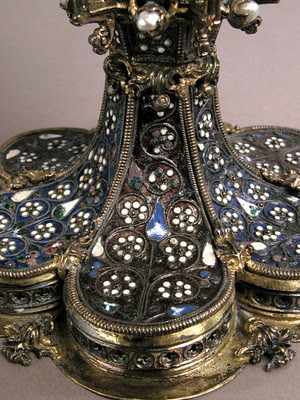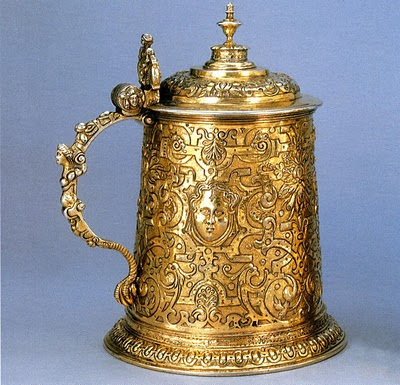 |
The Fonthill Vase
National Museum of Ireland, Dublin |
The so-called Gaigneres-Fonthill vase at the National Museum of Ireland, Dublin is regarded as the oldest well-documented Chinese porcelain object to enter Europe. It is a porcelain vase with bluish-white (qingbai) glaze, dating from the beginning of the 14th century. The history of the vase is given as follows in almost all available English-language sources: The vase arrived in Europe probably as a gift to King Louis the Great of Hungary, given by an embassy of Nestorian Christians from China, who visited Pope Benedict XII in 1338. The piece then supposedly was mounted by King Louis, and given as a gift to Charles III of Durazzo, upon his ascension to the throne of Naples in 1381 (after the defeat of Louis' hated enemy, Queen Joan). That would explain the combination of Hungarian and Neapolitan Angevin coat of arms mounted on top of the vase. This theory, first elaborated by Mazerolle in 1897 (Gazette des Beaux-Arts), is based on a drawing by Gaigneres from 1713, which depicts the elaborate medieval silver-gilt mounting and enameled heraldic decoration of the vase (Paris, Bibliotheque Nationale). Mazerolle did not know that the vessel, without its mount, was purchased by the National Museum of Ireland in 1882 for about £28.
The vase had been previously recorded at the Fonthill Abbey collection of William Beckford, which was sold in 1822-23, and the piece likely entered the Hamilton collection after that (The 'Hamilton palace sale' took place in 1882). The celebrated Chinese vase still had its mount preserved at Fonthill Abbey, as the following illustration proves (the picture comes from the book:
An Illustrated History and Description of Fonthill Abbey, by John Rutter, 1823 - available via
Google Books.)

The mount was removed at an unknown date during the 19th century, and the object entered the National Museum of Ireland unrecognized. The vase was identified by Arthur
Lane, who then pieced together the entire story ("The
Gaignieres-
Fonthill Vase - A Chinese Porcelain of about 1300,"
Burlington Magazine 103 (1961), 124-132). Lane's article is still the general reference on the object, cited by many (for example: David Whitehouse: "Chinese Porcelain in Medieval Europe," in
Medieval Archaeology, 1972,
see online here.). This information is also given by the
National Museum of Ireland website and the piece was featured with this data in an exhibition at the
Victoria and Albert Museum.
 |
The Gaigneres drawing of the vase
with its medieval mounting
Paris, BNF
|
The study of Arthur Lane, Keeper of the Department of Ceramics at the Victoria and Albert Museum, also appeared in Hungarian in the art history journal
Művészettörténeti Értesítő - sadly only after the premature
death of Lane. Béla Krisztinkovich, a Hungarian expert on ceramics, published a response to Lane's article in the same Hungarian journal. It appears that his publication remained unnoticed outside Hungary (Krisztinkovich, Béla, "Hozzászólás Arthur Lane a
Művészettörténeti Értesítő 1967/I. számában megjelent posztumusz cikkéhez a Gaignières-Fonthill vázáról,"
Művészettörténeti Értesítő 18, 1969/2, 187–192.). Krisztinkovich provides a close analysis of the Gaigneres drawing, which preserved the feature of the mount of the object, and its heraldic decoration. The heraldic decoration is that of the Neapolitan Angevin family, along with the coat of arm of the Hungarian Angevin kings. This of course gave rise to the theory outlined above. However, all branches of the Neapolitan Angevins had a claim to the throne of Hungary, and thus they used the Hungarian coat of arms in their heraldic representation as well. After analyzing the heraldic decoration and other features of the object in details, Krisztinkovich arrives at the conclusion that the vase was mounted for Queen Joan II, successor of King Ladislas at the throne of Naples (1414-1434). His father, Charles III of Naples was king of Hungary for a brief time (Charles II in Hungary) - but was murdered swiftly, making way ultimately for Sigismund of Luxemburg. Joan's brother, Ladislas, also claimed Hungary, but failed to obtain the crown. Similarly to her brother's claim, Joan used the title of Queen of Hungary until her death in 1435. The argument of Krisztinkovich is clinched by the inscription on the spout of the jug: JEHANA, clearly referring to Joan. Later, Jenő Horváth further elaborated this argument - his study is recommended as the best English-language overview of the Fonthill vase (reference below).








